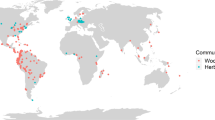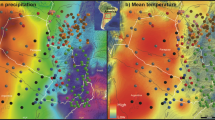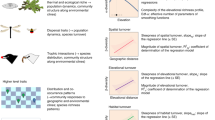Abstract
Patterns in phylogenetic diversity are poorly known for many taxonomic groups, including hyperdiverse insect taxa. We contrasted patterns in the species richness and phylogenetic diversity of provincial beetle faunas in northern Europe (54°N to 71°N). We found that species richness and phylogenetic diversity varied rather predictably along ecogeographical gradients, with species richness and a proxy measure of phylogenetic diversity, average taxonomic distinctness (AvTD), decreasing from south to north and being strongly positively related to maximum temperature. A proxy measure of variation in phylogenetic diversity, variation in taxonomic distinctness (VarTD), was also strongly related to maximum temperature, but the relationship was negative. This was a novel finding, showing a reversed latitudinal gradient in biodiversity. In more than half of the provinces, AvTD value was significantly less than expected by chance. Also, more than half of the provinces showed significantly higher VarTD values than expected based on random draws of species. Our results showed that the phylogenetic diversity of beetle faunas is rather strongly associated with climatic gradients at high latitudes. Given that climatic variability and temperature extremes are correlated with phylogenetic diversity, climate change is likely to modify strongly this facet of diversity. Average phylogenetic diversity is likely to increase in the northernmost parts of the study area if climate and vegetation become more suitable for many southern beetle species. Our statistical approach to test chance expectations based on random draws of species from larger-scale species pool is highly flexible in tackling this question when true phylogenies are not available.


Similar content being viewed by others
References
Alahuhta J, Heino J, Luoto M (2011) Climate change and the future distribution of aquatic macrophytes across boreal catchments. J Biogeogr 38:383–393
Anisimov OA, Vaughan DG, Callaghan TV, Furgal C, Marchant H, Prowse TD, Vilhjálmsson H, Walsh JE (2007) Polar regions (Arctic and Antarctic). Climate change 2007: impacts, adaptation and vulnerability. In: Parry ML, Canziani OF, Palutikof JP, van der Linden PJ, Hanson CE (eds) Contribution of Working Group II to the fourth assessment report of the intergovernmental panel on climate change. Cambridge University Press, Cambridge, pp 653–685
Baños-Picón L, Asís JD, Gayubo SF, Tormos J (2009) Analyzing insect community structure through the application of taxonomic distinctness measures. Zool Studies 48:298–314
Betzholtz P-E, Petterson LB, Ryrholm N, Franzén M (2012) With that diet, you will go far: trait-based analysis reveals a link between rapid range expansion and nitrogen-favoured diet. Proc Royal Soc B. 280:2012–2305
Bílý S (1982) The Buprestidae (Coleoptera) of Fennoscandia and Denmark. Fauna Entomol Scand 10:1–110
Bílý S, Mehl O (1989) Longhorn beetles (Coleoptera, Cerambycidae) of Fennoscandia and Denmark. Fauna Entomol Scand 22:1–203
Cadotte MW, Cavender-Bares J, Tilman D, Oakley TH (2009) Using phylogenetic, functional and trait diversity to understand patterns of plant community productivity. PLoS ONE 4:e5695
Chatrou LW, Wieringa JJ, Couvreur TLP (2010) The impact of climate change on the origin and future of East African rainforest trees. In: Hodkinson TR, Jones MB, Waldren S, Parnell JAN (eds) Climate change, ecology and systematics. Cambridge University Press, Cambridge, pp 304–319
Clarke KR, Warwick RM (1998) A taxonomic distinctness index and its statistical properties. J Appl Ecol 35:523–531
Clarke KR, Warwick RM (2001a) A further biodiversity index applicable to species lists: variation in taxonomic distinctness. Mar Ecol Progr Ser 216:265–278
Clarke KR, Warwick RM (2001b) Change in marine communities. An Approach to Statistical Analysis and Interpretation. PRIMER-E, Plymouth
Cowie J (2013) Climate change. Biological and human aspects, 2nd edn. Cambridge University Press, Cambridge
Currie DJ, Mittelbach GG, Cornell HV, Field R, Guégan J-F, Hawkins BA, Kaufman DM, Kerr JT, Oberdorff T, O’Brien E, Turner JRG (2004) Predictions and tests of climate-based hypotheses of broad-scale variation in taxonomic richness. Ecol Lett 7:1121–1134
Danks HV (1992) Arctic insects as indicators of environmental change. Arctic 45:159–166
Devictor V, Mouillot D, Meynard C, Jiguet F, Thuiller W, Mouquet N (2010) Spatial mismatch and congruence between taxonomic, phylogenetic and functional diversity: the need for integrative conservation strategies in a changing world. Ecol Lett 13:1030–1040
Devictor V, van Swaay C, Brereton T, Brotons L, Chamberlain D, Heliölä J, Herrando S, Julliard R, Kuussaari M, Lindström Å, Reif J, Roy DB, Schweiger O, Settele J, Stefanescu C, Van Strien A, Van Turnhout C, Vermouzek Z, WallisDeVries M, Wynhoff I, Jiguet F (2012) Differences in the climatic debts of birds and butterflies at a continental scale. Nature Clim Chang 2:121–124
Diniz-Filho JAF, Bini LM, Hawkins BA (2003) Spatial autocorrelation and red herrings in geographical ecology. Global Ecol Biogeogr 12:53–64
Diniz-Filho JAF, De Marco Jr P, Hawkins BA (2010) Defying the curse of ignorance: perspectives in insect macroecology and conservation biogeography. Ins Cons Divers 3:172–179
Fattorini S (2014) Disentangling the effects of available area, mid-domain constraints, and species environmental tolerance on the altitudinal distribution of tenebrionid beetles in a Mediterranean area. Biodivers Conserv 23:2545–2560
Fattorini S, Ulrich W (2012a) Drivers of species richness in European Tenebrionidae (Coleoptera). Acta Oecol 36:255–258
Fattorini S, Ulrich W (2012b) Spatial distributions of European Tenebrionidae point to multiple postglacial colonization trajectories. Biol J Linn Soc 105:318–329
Fordham DA, Akçakaya HR, Araújo M, Brook BW (2013) Modeling range shifts for invasive vertebrates in response to climate change. In: Brodie JF, Post E, Doak D (eds) Wildlife conservation in a changing climate. University of Chicago Press, Chicago, pp 86–108
Fox J (2005) The R commander: a basic statistics graphical user interface to R. J Stat Soft 14:1–42
Fritz SA, Rahbek C (2012) Global patterns of amphibian phylogenetic diversity. J Biogeogr 39:1373–1382
Hansen M (1987) The Hydrophiloidea of fennoscandia and Denmark. Fauna Entomol Scand 18:1–254
Hawkins BA, Diniz-Filho JAF (2004) ‘Latitude’ and geographic patterns in species richness. Ecography 27:268–272
Hawkins BA, Porter EE, Diniz-Filho JAF (2003) Productivity and history as predictors of the latitudinal diversity gradient of terrestrial birds. Ecology 84:1608–1623
Hawkins BA, Diniz-Filho JAF, Jaramillo CA, Soeller SA (2007) Climate, niche conservatism and the global bird diversity gradient. Am Nat 170:516–527
Heino J (2001) Regional gradient analysis of freshwater biota: do similar biogeographic patterns exist among multiple taxonomic groups?. J Biogeogr 28:69–77
Heino J, Alahuhta J (2015) Elements of regional beetle faunas: faunal variation and compositional breakpoints along climate, land cover and geographical gradients. J Anim Ecol 84:427–441
Heino J, Mykrä H, Hämäläinen H, Aroviita J, Muotka T (2007) Responses of taxonomic distinctness and species diversity indices to anthropogenic impacts and natural environmental gradients in stream macroinvertebrates. Freshwat Biol 52:1846–1861
Heino J, Virkkala R, Toivonen H (2009) Climate change and freshwater biodiversity: detected patterns, future trends and adaptations in northern regions. Biol Rev 84:39–54
Hewitt GM (1999) Post-glacial re-colonization of European biota. Biol J Linn Soc 68:87–112
Hickling R, Roy DB, Hill JK, Fox R, Thomas CD (2006) The distributions of a wide range of taxonomic groups are expanding polewards. Glob Change Biol 12:450–455
Hidasi-Neto J, Loyola R, Cianciaruso MV (2015) Global and local evolutionary and ecological distinctiveness of terrestrial mammals: identifying priorities across scales. Divers Distr 21(5):548–549
Hijmans RJ, Cameron SE, Parra JL, Jones PG, Jarvis A (2005) Very high resolution interpolated climate surfaces for global land areas. Int J Climat 25:1965–1978
Hodkinson ID (2005) Terrestrial insects along elevation gradients: species and community responses to altitude. Biol Rev 80:489–513
Holmen M (1987) The aquatic adephaga (Coleoptera) of Fennoscandia and Denmark, Volume I. Gyrinidae, Haliplidae. Hygrobiidae and Noteridae. Fauna Entomol Scand 20:1–168
IPCC (2014) Climate Change. Synthesis Report. Available at: http://ipcc.ch/index.htm
Kaspari M, O’Donnell S, Kercher JR (2000) Energy, density, and constraints to species richness: ant assemblages along a productivity gradient. Am Nat 155:280–293
Keil P, Dziock F, Storch D (2008) Geographical patterns of hoverfly (Diptera, Syrphidae) functional groups in Europe: inconsistency in environmental correlates and latitudinal trends. Ecol Entomol 33:748–757
Kerr JT, Southwood TRE, Cihlar J (2001) Remotely sensed habitat diversity predicts butterfly species richness and community similarity in Canada. Proc Nat Acad Sci 98:11365–11370
Kühn I, Dormann CF (2012) Less than eight (and a half) misconceptions of spatial analysis. J Biogeogr 39:995–998
Leather SR (2009) Taxonomic chauvinism threatens the future of entomology. Biologist 56:10–13
Legendre P, Legendre L (2012) Numerical ecology, 3rd edn. Elsevier, Amsterdam
Lenton TM, Held H, Kriegler E, Hall JW, Lucht W, Rahmstorf S, Schellnhuber HJ (2008) Tipping elements in the Earth’s climate system. Proc Nat Acad Sci 105:1786–1793
Lindroth CH (1985) The Carabidae (Coleoptera) of Fennoscandia and Denmark. Fauna Entomol Scand 15:1–225
Lindroth CH (1986) The Carabidae (Coleoptera) of Fennoscandia and Denmark. Fauna Entomol Scand 15:226–497
Lomolino MV, Riddle BR, Whittaker RJ, Brown JH (2010) Biogeography, 4th edn. Sinauer Associates Inc., Sunderland
Luz Ribeiro P, Rapini A, Soares e Silva UC, Ungareti Paleo Konno T, Santos Damascena L, van den Berg C (2012) Spatial analyses of the phylogenetic diversity of Minaria (Apocynaceae): assessing priority areas for conservation in the Espinhaço Range, Brazil. Syst Biodiv 10:317–331
Magurran A (2004) Measuring biological diversity. Blackwell Publishing, Malden
Malcolm JR, Liu C, Neilson RP, Hansen L, Hannah L (2006) Global warming and extinctions of endemic species from biodiversity hotspots. Cons Biol 20:538–548
Mazel F, Guilhaumon F, Mouquet N, Devictor V, Gravel D, Renaud J, Cianciaruso MV, Loyola R, Diniz-Filho JAF, Mouillot D, Thuiller W (2014) Multifaceted diversity–area relationships reveal global hotspots of mammalian species, trait and lineage diversity. Glob Ecol Biogeogr 23(8):836–847
Mouquet N, Devictor V, Meynard CN, Munoz F, Bersier LF, Chave J, Couteron P, Dalecky A, Fontaine C, Gravel D, Hardy OJ, Jabot F, Lavergne S, Leibold M, Mouillot D, Munkemuller T, Pavoine S, Prinzing A, Rodrigues ASL, Rohr RP, Thebault E, Thuiller W (2012) Ecophylogenetics: advances and perspectives. Biol Rev 87:769–785
Nilsson AN, Holmen M (1995) The aquatic adephaga of Fennoscandia and Denmark 2. Dytiscidae. Fauna Entomol Scand 32:1–188
Oksanen J, Blanchet FG, Kindt R, Legendre P, Minchin PR, O’Hara RB, Simpson GL, Solymos P, Stevens MHH, Wagner H (2014). vegan: Community Ecology Package. R package version 2.2-0. http://CRAN.R-project.org/package=vegan
Paradis E, Claude J, Strimmer K (2004) APE: analyses of phylogenetics and evolution in R language. Bioinformatics 20:289–290
Parmesan C (2006) Ecological and evolutionary responses to recent climate change. Annu Rev Ecol Evol Syst 37:637–669
Pio DV, Engler R, Linder HP, Monadjem A, Cotterill FPD, Taylor PJ, Schoeman MC, Price BW, Villet MH, Eick G, Salamin N, Guisan A (2014) Climate change effects on animal and plant phylogenetic diversity in southern Africa. Glob Change Biol 20:1538–1549
Posadas P, Esquivel DR, Crisci JV (2001) Using phylogenetic diversity measures to set priorities in conservation: an example from southern South America. Biol Cons 15:1325–1334
Purvis A, Gittleman JL, Brooks T (Eds) (2005) Phylogeny and conservation. Cambridge University Press, Cambridge
Rahbek C, Graves GR (2001) Multiscale assessment of patterns of avian species richness. Proc Nat Acad Sci 98:4534–4539
Ricklefs RE, Jenkins DG (2011) Biogeography and ecology: towards the integration of two disciplines. Phil Trans Royal Soc B 266:2438–2448
Ricklefs RE, Hong Q, White PS (2004) The region effect on mesoscale plant species richness between eastern Asia and eastern North America. Ecography 27:129–136
Ricotta C, Bacaro G, Marignani M, Godefroid S, Mazzoleni S (2012) Computing diversity from dated phylogenies and taxonomic hierarchies: does it make a difference to the conclusions? Oecologia 170:501–506
Rödder D, Schmidtlein S, Schick S, Lötters S (2011) Climate envelope models in systematics and evolutionary research: theory and practice. In: Hodkinson TR, Jones MB, Waldren S, Parnell JAN (eds) Climate change. Cambridge University Press, Ecology and Systematics, pp 243–264
Rosenzweig ML (1995) Species diversity in space and time. Cambridge University Press, Cambridge
Rull V (2014) Macrorefugia and microrefugia: a response to Tzedakis et al. Trends Ecol Evol 22:243–244
Sanders NJ (2002) Elevational gradients in ant species richness: area, geometry, and Rapoport’s rule. Ecography 25:25–32
Schneeweiss GM, Schönswetter P (2011) A re-appraisal of nunatak survival in arctic-alpine phylogeography. Mol Ecol 20:190–192
Srivastava DS, Cadotte MW, MacDonald AA, Marushia RG, Mirotchnick N (2012) Phylogenetic diversity and the functioning of ecosystems. Ecol Lett 15:637–648
Stevens GC (1992) The elevational gradient in altitudinal range: an extension of Rapoport’s latitudinal rule to altitude. Am Nat 140:893–911
Stewart JR, Lister AM, Barnes I, Dalén L (2010) Refugia revisited: individualistic responses of species in space and time. Proc R Soc B 277:661–671
Strecker AL, Olden JD, Whittier JB, Paukert CP (2011) Defining conservation priorities for freshwater fishes according to taxonomic, functional, and phylogenetic diversity. Ecol Appl 21:3002–3013
Thomas MC (2008) Beetles (Coleoptera). In: Capinera JL (ed) Encyclopedia of entomology, 2nd edn. Springer, Berlin, pp 437–447
Thomas CD, France AMA, Hill JK (2006) Range retractions and extinction in the face of climate warming. Trends Ecol Evol 21:415–416
Thuiller W, Lavergne S, Roquet C, Boulangeat I, Lafourcade B, Araujo MB (2011) Consequences of climate change on the tree of life in Europe. Nature 470:531–534
Tolimieri N, Anderson MJ (2010) Taxonomic distinctness of demersal fishes of the California current: moving beyond simple measures of diversity for marine ecosystem-based management. PLoS ONE 5:e10653
Tzedakis PC, Emerson BC, Hewitt GM (2013) Cryptic or mystic? Glacial tree refugia in northern Europe. Trends Ecol Evol 28:696–704
Väisänen R, Heliövaara K (1994) Hot-spots of insect diversity in northern Europe. Ann Zool Fenn 31:71–81
Väisänen R, Heliövaara K, Immonen A (1992) Biogeography of northern European insects: province records in multivariate analysis (Saltatoria, Lepidoptera: Sesiidae; Coleoptera: Bubrestidae, Cerambycidae). Ann Zool Fenn 28:57–81
Wang Z, Brown JH, Tang Z, Fang J (2009) Temperature dependence, spatial scale, and tree species diversity in eastern Asia and North America. Proc Nat Acad Sci 106:1388–1392
Warwick RM, Clarke KR (1995) New “biodiversity” measures reveal a decrease in taxonomic distinctness with increasing stress. Mar Ecol Progr Ser 129:301–305
Winter M, Devictor V, Schweiger O (2013) Phylogenetic diversity and nature conservation: where are we? Trends Ecol Evol 28:199–204
Acknowledgments
We thank the Academy of Finland for financial support, and Maija Lantto and Riikka Savolainen for compiling the beetle data.
Author information
Authors and Affiliations
Corresponding author
Additional information
Communicated by Dirk Sven Schmeller.
Electronic supplementary material
Below is the link to the electronic supplementary material.
Rights and permissions
About this article
Cite this article
Heino, J., Alahuhta, J. & Fattorini, S. Phylogenetic diversity of regional beetle faunas at high latitudes: patterns, drivers and chance along ecological gradients. Biodivers Conserv 24, 2751–2767 (2015). https://doi.org/10.1007/s10531-015-0963-z
Received:
Revised:
Accepted:
Published:
Issue Date:
DOI: https://doi.org/10.1007/s10531-015-0963-z




